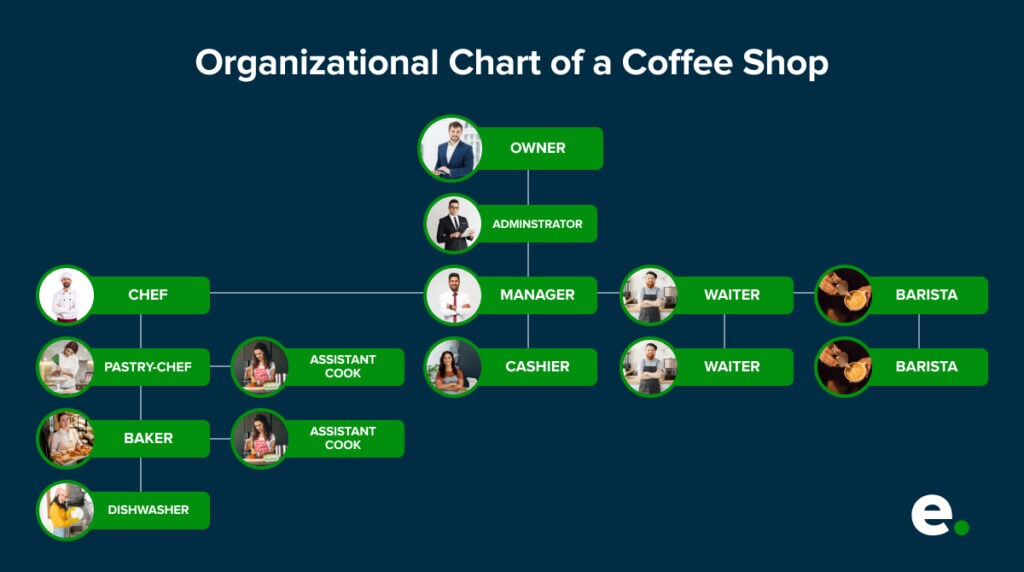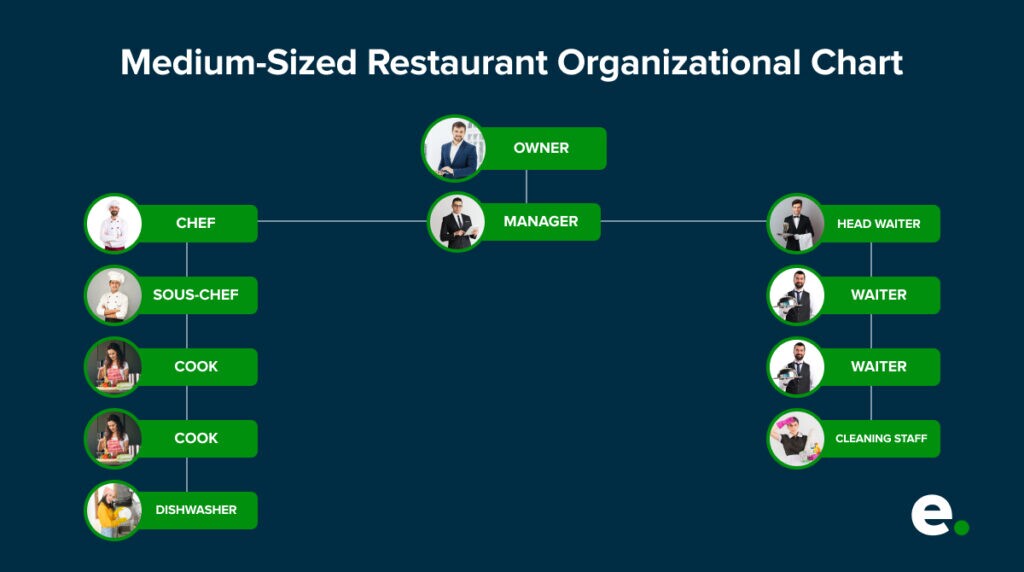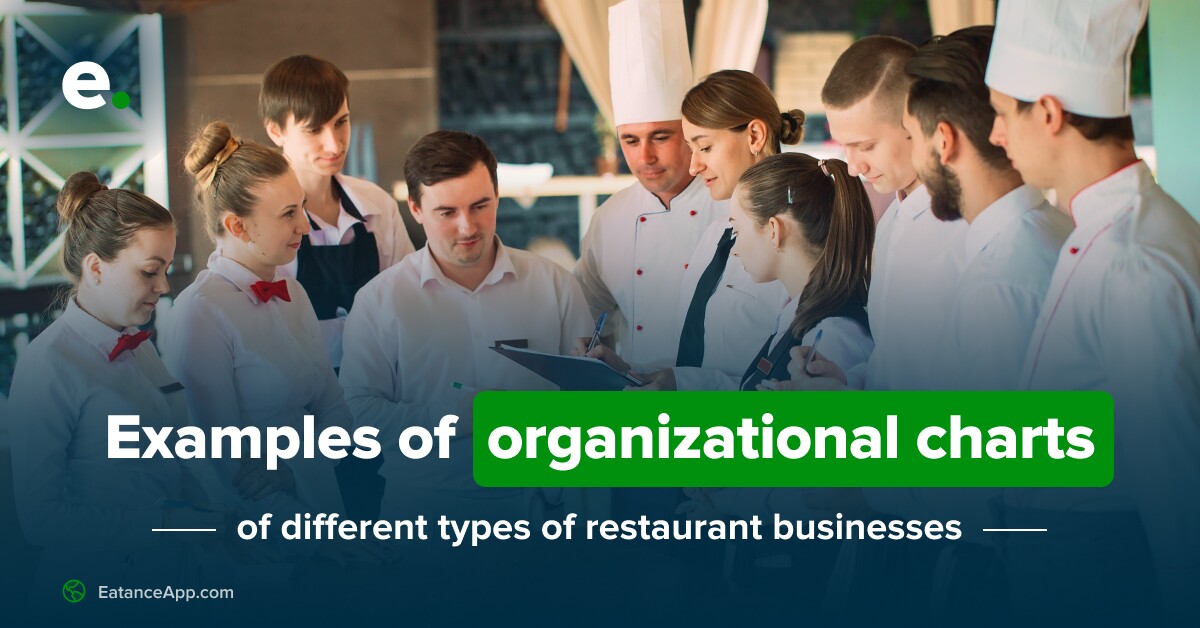'The only difference between a mob and a trained army is organization'- these words by Calvin Coolidge seem relatable in every venture one sets out for. Good organization of tasks and workforce works like a car wiper works while driving in the rain. It clears up the vision for a smooth journey. While the organization is essential everywhere, we would like to steer your attention to its efficiency and effectiveness in the restaurant business. Maintaining a hierarchy and sophisticated processes while opening a restaurant can help you save days while reducing overhead costs.
The primary step of maintaining an organization in the restaurant business is developing an organizational restaurant chart. It basically is a flowchart to display the team's duties in a hierarchical structure. There are a variety of organizational charts based on the type of restaurants. This article lists a few examples of restaurant organizational charts for a quick and productive start to your restaurant's organization.
What are the different positions in restaurant based on organizational chart?
Though every restaurant has its own needs for staff and human resources, some of the standards and elementary are:
- Owner- Depending on the type and scale of a restaurant, the duties of an owner vary. Always heading the organizational charts, the owners act as managers, cashiers, receptionists, etc., in small-scale restaurants and carry money-related matters only in large-scale restaurants.
- Administrator- Usually, full-service gourmet restaurants have administrators who have a complex and big staff to manage.
- The Manager- A restaurant manager is the most responsible employee and looks after the restaurant's recruitment, training, operations, and overall functioning. From customer satisfaction to restaurant compliance and regulations, the manager has to ensure flawlessness in every nook and corner of the restaurant.
- Executive Chef- Head chef deals with the functioning of kitchen operations and manages the kitchen staff and supplies.
- Sous Chef- Sous chef is often regarded as the assistant chef and he manages the pre and post-cooking operations like getting the kitchen ready and plating the dishes.
- Waiters- Waiters are the front-of-the-house staff responsible for serving and assisting customers.
- Security-Security personnel in the restaurants are subjected to the type of crowd and scale of the restaurant.
What is the importance of Organizational Chart in food service industry?
Let us introduce you to the many reasons for having a restaurant organization chart.
Having an efficient chart helps you:
- Manage the hiring with efficient position fillings.
- Acknowledging the functions of each position.
- Maintaining the operational chain and budget.
- Interlink the duties.
- Optimize the operations.
What are the examples of different restaurant business organizational charts?
Coffee Shop organizational Chart
A cafe is an example of a small, themed restaurant serving specific cuisine. Such restaurants don't have many employees; each employee usually plays more than one role.

The organizational chart shown has the owner at the top. In small restaurants or cafes, usually, owners double up as managers. The manager, may it be the owner or an employed manager, is responsible for the overall functioning of the restaurant and improving the customer experience. In coffee shops or cafes, as the menu is restricted to a constrained cuisine, they generally don't have an executive and sous chef. Instead, they have special bakers, confectioners, and baristas. Big cafes have assistant bakers too, for fast services.
Waiters in these cafes depend on the restaurant's size and scale and have a distinct cleaning staff.
Medium Scale Restaurant Organization Chart
Medium-scale restaurants share the maximum proportion in the industry and need significant planning and organization. The chart example for such a restaurant displayed has an expanded human resource with diverse duties for each role. The owner heading the chart, the responsible shoulders of the manager in medium-scale restaurants due to budget crunches and liability balancing, the manager fulfills the role of the cashier or even receptionist.

In the given example, kitchen responsibility is solely put on the executive chef, who is also the kitchen supervisor. He also manages the waiters and the waiters directly report to him for orders and queries.
Waiters usually do cleaning duties, or one person is allotted for the same.
Small restaurants are visited mostly by families and thus have special needs for staff and management. The example in the chart fulfills most of the needs of such restaurants.
The chart heads the manager as he is the leading supervisor of the entire staff. Like cafés, most small restaurants have a manager in a double role like the receptionist and the cashier.
Small restaurants have a head chef who manages the kitchen activities and decides the menu and dishes. In addition, small restaurants have one or two waiters that act as sous chefs when required.
The cleaning staff is generally missing, and waiters do the cleaning jobs, as small restaurant budgets are crunched.
Organizational Structure of a Full-Service Restaurant
The next example depicts an organizational chart for a full-service restaurant. Due to their complex organization, these restaurant businesses need a huge staff and specified duties for efficient functioning. Catering to big crowds, these restaurants have a highly managed hierarchy of roles.The owner of these restaurants is generally just the monetary supplier, and the rest of the roles are done by hired employees. Headed by an administrator, who manages supplies, financial compliance, promotion, and other administrative jobs, this chart is very immersive.

The restaurant's manager deals with the routine functioning of the restaurant and supervises the entire staff. Full-service restaurants often have separate kitchen managers that handle kitchen operations and supplies and directly report to the manager or administrator.
Next in the flowchart comes the executive chef responsible for the restaurant's lip-smacking menu and reports to the kitchen manager. An executive chef also handles the functioning of the kitchen.
Since full-service restaurants tend to provide influential services, these restaurants have a sous chef who supervises the plating and presentation of the dishes. In addition, he plays a vital role in bulk orders and manages crockery and cutlery.
Since these restaurants are high-end stations with multiple cuisines on the menu, each station in the kitchen has a station chef that specializes in the specialized cuisine.
The cleaning staff resorts to cleaning and equipment organization only.
Waitressing staff have their own head that guides and manages all other waiters and oversees the smooth functioning of the restaurant, especially in peak hours.
The features and efficiency of such grand restaurants are specialized bartenders and sommeliers who handle drinks for the customers.
The cleaning staff has a full back-of-house and front-of-house team to maintain cleanliness and hygiene in the restaurant.
The Head of security manages the guards, valet, bouncers, if any, and CCTV security.
Fast Food Restaurant organizational chart
Fast food restaurants are entirely different from regular restaurants and need a well-planned and managed organizational chart for the swift and smooth functioning of the outlet. In addition, large-scale fast-food restaurants tend to turn into the franchise business, and thus the workforce is very much varied.

The example of the organizational chart displayed depicts the duties specified for the staff and is developed for maximum efficiency of operations. Fast food restaurants have an individual or team that has the supervising entity for hirings and handling the administrative functions. The staff is managed and supervised by the manager of the restaurant
Large-scale fast-food restaurants also have assistant managers that handle deliveries and drive-thru orders.
Besides having executive chefs, fast food restaurants have specialized assistant cooks. The rest of the staff includes cleaners, waiters, security personnel, etc., as per the requirement.
In case you want to know top 10 restaurant staffing issue and how to solve them.
Points to remember
No two restaurants are the same and so not are their requirements. The above charts are for reference purposes and you are suggested to prepare your personalized organizational chart considering your unique needs. Here are some tips you can count on while developing your restaurant's organizational chart.
- Stick to a simple flowchart and start from the top position of the owner and maintain the flow towards the bottom positions.
- Consider the employee's functions as the decisive factor while setting up the chart.
- Keep track of daily orders and budgets while fixing the staff in the chart.
Making the organizational chart will be mere a flowchart project if you don't implement it properly and efficiently. Get the chart prepared thoughtfully and wisely and put it to execution to complete terms. Indulge your staff in adding to the productivity of your restaurant and make it a successful venture.
![Multi Restaurant Aggregator [MRP]](https://cdn-iladimn.nitrocdn.com/oNoxxWIWAFMwEZIfPlwOisJGNebYevke/assets/images/optimized/rev-1fe34f2/eatanceapp.com/wp-content/uploads/2022/03/Hamburger.svg)





